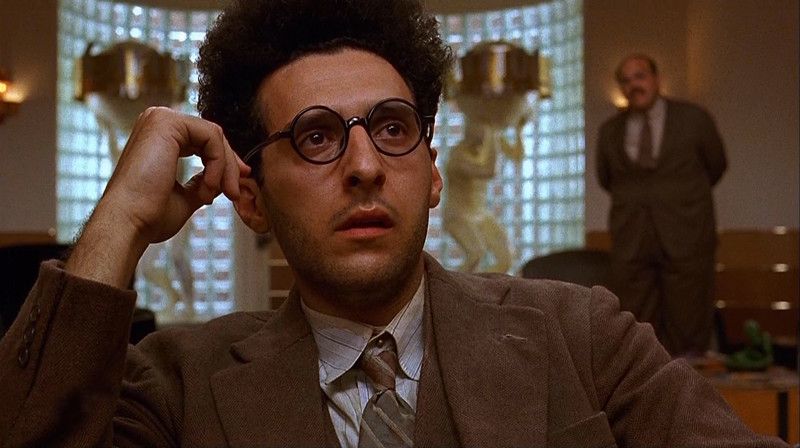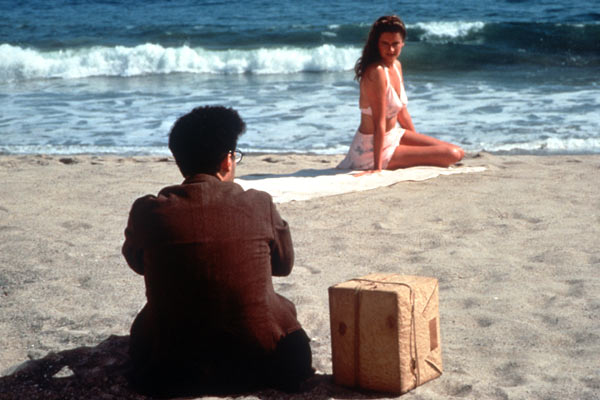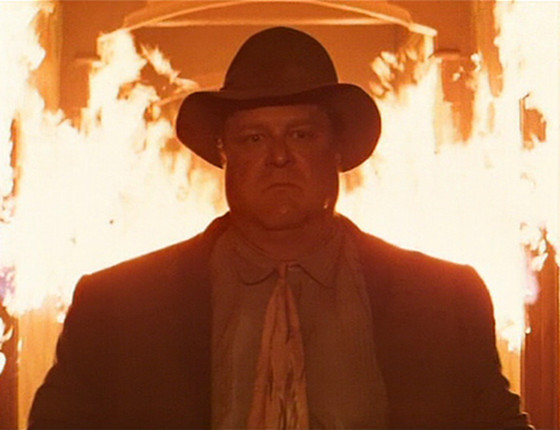
“A movie I really love is Barton Fink… I feel like there’s so much in there, you could watch it again and again.”
– Charlie Kaufman
Lost for words
For a fact one of the Coen brothers’ most sideways mash-ups, Barton Fink synthesizes entertainment industry satire, film noir, the surreal, Künstlerroman designs, and the stark psychological horror of Roman Polanski (elements of his Apartment trilogy are explicitly referenced), all with the scrupulous visual style they’ve become synonymous with.
Their first outing with cinematographer du jour Roger Deakins (they’ve now done a total of 12 and counting films together to date), here united they hem in Hollywood of the early 1940s, depicting a doleful world of Art Deco, endless hotel corridors, deep luxurious swimming pools, and long, impenetrable shadows.
The affluent and upscale Hollywood presented here in Barton Fink, just inching out of the Depression and writhing into the light, holds apprehension and hatred just below its posh and superficial surface.
Set in 1941, Barton Fink chronicles the journey of one man who would, after some emotional bargaining and soul searching, ultimately enjoy selling out to the bright lights of Hollywood, if only he had the knack and know-how to do so.
Barton Fink (John Turturro), a New York playwright who has tasted some early success, has accepted an offer to move to L.A. where he promptly finds himself afflicted with writer’s block after assigned a lousy B-movie picture about wrestling. But Barton’s misstepping has only begun.
“[Barton Fink] is kind of a Polanski movie. It is closer to that than anything else.”
– Ethan Coen
For my head is bending low

Fink, a left-leaning and self-important intellectual, the Coens saw fit to imbue this easy mark with writer’s block as this too had afflicted them when they found themselves battling with a problematic script while writing Miller’s Crossing (1990). They felt they’d written themselves into the proverbial corner with that project and so took a three week vacay from that quagmire to instead write a hopefully rejuvenative tale about a screenwriter struggling with the same infirmity.
This inoculative measure worked well for them, and Barton Fink (which they both wrote but which Joel directed, Ethan produced, and they both edited under their regular alias “Roderick Jaynes”) would go on to become a successful outing for all involved, if you ignore the fact that it didn’t break even at the box-office. In fact, while it may not rank high on their overall oeuvre––depending who you ask, of course––Barton Fink would score them scads of street cred.
The film won the Palme d’Or at the 1991 Cannes Film Festival, but it didn’t stop there, also netting Best Director and Best Actor honors. It was due to this award winning coup d’état that Cannes changed their guidelines so that no future films could ever sweep all three major awards again.
In his 2007 book entitled “Postmodern Hollywood: What’s New in Film and Why It Makes Us Feel So Strange,” author M. Keith Booker articulates that he sees Barton Fink as a spirited “postmodern pastiche,” emphasizing how, as a period film and as a movie about a bygone era of Hollywood it “views the past not as the prehistory of the present but as a warehouse of images to be raided for material.” This certainly accounts for much of the artful window dressing that makes the movie so opaque and, at times, rather restless.
“You’re going to be hearing a lot about Barton Fink… Gnomic, claustrophobic, hallucinatory, just plain weird, it is the kind of movie critics can soak up thousands of words analyzing and cinephiles can soak up at least three espressos arguing their way through.”
– Richard Schickel, TIME Magazine
Killing the dream

Once in Hollywood, Barton, who himself is modelled not necessarily in an honoring fashion after real-life NYC playwright and intellectual Clifford Odets (writer of the 1930s Broadway successes Awake and Sing! and Waiting for Lefty), where he is called upon by Hollywood bigwig and mighty studio mogul of Capitol Pictures, Jack Lipnick (Michael Lerner in a role that got him a Best Actor in a Supporting Role Academy Award nomination).
Lipnick is an amalgam several real-life Hollywood producers from that era, most notably Louis B. Mayer, and Jack L. Warner. An absolutely crass rube, he barely listens to anything Barton has to say as he foists piles of money at him to write a shit movie well beneath what he know of the writer’s ambient and interests.
A likable but rather dimly devoted goose egg, Barton next checks in to the Hotel Earle, where much of the film unfolds and a place that feels like a fever dream shared by The Shining-era Stanley Kubrick and Edward Hopper in his prime. It’s an eerie, seemingly empty place that could, perhaps if one wanted to read a lot into it, represent a kind of purgatory of peeling wallpaper or a gruesome Gehenna.
Legend has it that when the Coens were making their first feature, 1984’s Blood Simple, in Austin, Texas, that there was a rather menacing looking hotel across the street from their converted warehouse studio that provided the inspiration and impression for the Hotel Earle.
At the hotel, where the rather listless and archly comical desk clerk Chet (Steve Buscemi) resides, and where Barton’s room is a meager one of muted colors and a strangely significant painting of a woman at the beach, arm raised as if to shield her eyes from the sun as she stares out to sea, it’s here that Barton soon meets the disarmingly amiable Charlie Meadows (John Goodman).
Charlie, a traveling salesman who dwells in the room next door to Baron’s, and is it seems, possibly the only other tenant in the vast hotel, soon reveals himself to be something of a raconteur and the two become fast friends. And while a few red flags reveal themselves to the audience but not at all to Barton, he’s contented, somewhat, to have a consort in his newly adopted home.
Your evil little aura, prowling, and casting a numbness on my mind

As Barton attempts to write his palooka picture the words won’t come and so he meets with the czar of Capitol Pictures, Lou Breeze (Jon Polito), another eccentric in the Coen’s compendium of odd birds, who points him towards the writer W.P. Mayhew (John Mahoney, excellent), a Southern gentleman and wordsmith in the William Faulkner vein. Revealed to be a raving lush his secretary Audrey Taylor (Judy Davis, wonderful), who has secrets of her own, soon captures Barton’s interests in ways that aren’t altogether healthy or wholesome.
But for all the shaggy dog detours and slapstick deflections that Barton Fink endures, it’s Goodman’s seemingly unconcerned and quotidian man in the next room that really ratchets the movie into darker genre territory. The film takes a dark dip into horror as Charlie’s cruel nature and unforthcoming nature is revealed in a bleak breadth of view that contains the ominous gestures of prophecy; bloodletting, conflagration, and utter destruction.
Barton Fink has been considered to be one of the Coen brothers’ more polarizing films, perhaps owing to some interpretive flourishes, shocking tonal shifts, surreal symbolism, and uncompromising dervishes. That it twists and turns to and fro from arthouse hustle to midnight movie promenade may be too ambitious or exhausting for some, perhaps.
But whenever a film goes off the rails it’s bound to spout and spit out a few partakers along the way. But isn’t that part of the risk that’s made the Coens who they are today? Barton Fink is a savage and cinematic thrill ride that’s best endured by the brave and where a tidy resolution lays anywhere but here.
“I gotta tell you, the life of the mind… There’s no roadmap for that territory.”
– Barton Fink (played by John Turturro)
Author Bio: Shane Scott-Travis is a film critic, screenwriter, comic book author/illustrator and cineaste. Currently residing in Vancouver, Canada, Shane can often be found at the cinema, the dog park, or off in a corner someplace, paraphrasing Groucho Marx. Follow Shane on Twitter @ShaneScottravis.